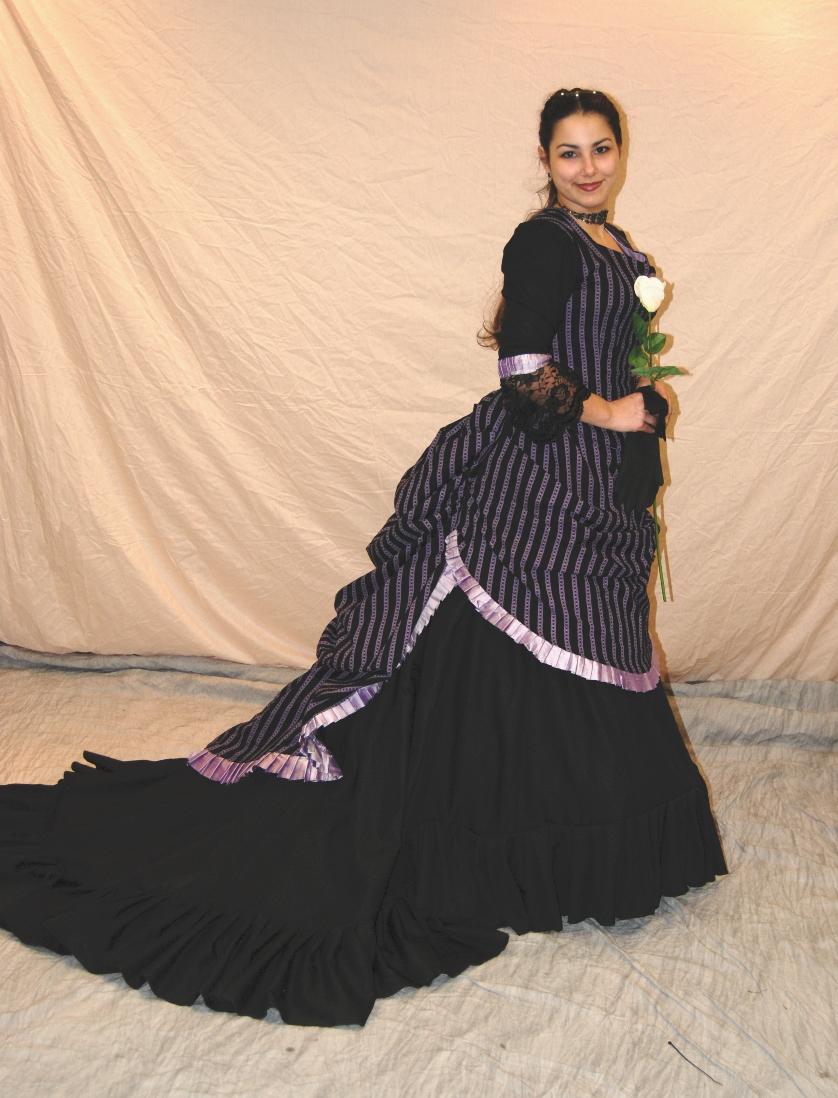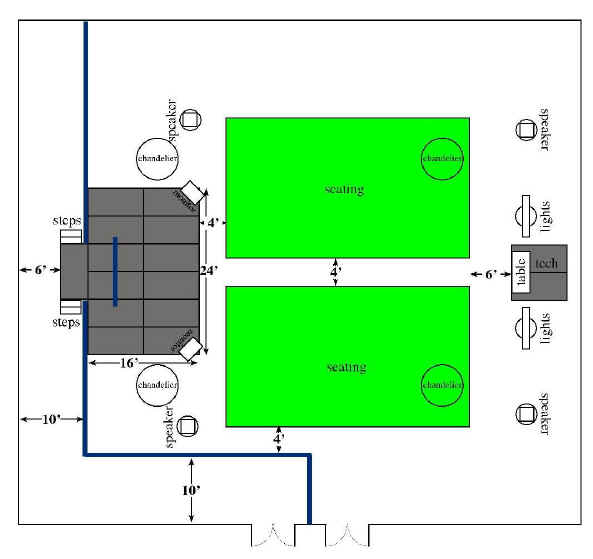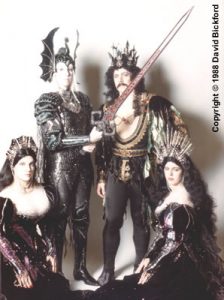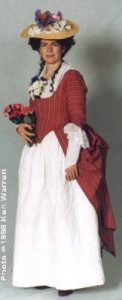CC25-H-03a: Bon Voyage
CC25-H-03a: Bon Voyage | Division: Novice | Category: Hist. Dress | Designer(s): Jackie Thomas | Maker(s): Jackie Thomas | Presenter(s): Jackie Thomas, Leticia Llamas and Junior Llamas | Workmanship Award(s): Best in Class | Presentation Award(s): Best in Class | Documentation Award(s): Most Imaginative Presentation of Documentation | Additional Award(s): Free Membership to CC27 (Photo ID: Kerry Gilley | Event Date: 2007)
Competition Staff & Rules
Staff:
- Director: Byron Connell
- Master of Ceremonies: Toni Lay*
- Presentation Judges: Nora Mai, Karen Heim and Richard Hyll*. Clerk: Jeff Morris
Rules:
Historical Masquerade
The CC 25 Historical Masquerade will take place on Sunday. Byron Connell is our Historical Masquerade director and we will publish the masquerade rules separately and in later PRs.
The Historical Masquerade will recognize creativity, scholarship, stage presentation, and workmanship skills in the context of historical clothing. It will celebrate the history of costume, including all cultures, periods, and types of dress.
CC25 marks Costume-Con’s quarter-century of existence. CC1 was held in January 1983; in honor of that anniversary, except in the two categories described below, the Historical Masquerade will limit entries to costume based on clothing that was worn or could have been worn through December 1982. In addition to the traditional entries reproducing historical dress in exact or modified form, the CC25 Historical Masquerade will accept entries in two special categories:
1. Ethnic costume or dress of any period (including the present).
2. Costumes reproducing works of art drawing, painting, or sculpture, Western or non-Western — from the ancient world to the present.
Ever wanted to do a costume with wings in a historical masquerade? How about the Nike of Samothrace? We look forward to your entries and to a great show!
Historical Masquerade Rules
Costume-Con 25 Historical Masquerade: Byron P. Connell, Director
1. The Costume-Con 25 Historical Masquerade recognizes creativity, scholarship, stage presentation, and workmanship skills in the context of historical clothing. It celebrates the history of costume, including all cultures, periods, and types of dress. “Historical costume” is costume based on clothing that was worn or could have been worn somewhere in the world.
2. CC25 marks Costume-Con’s quarter-century of existence. CC 1 was held in January 1983; in honor of that anniversary, except in the categories of Ethnic Costume or dress and Works of Art, the Historical Masquerade will limit entries to costume based on clothing that was worn or could have been worn through December 31, 1982.
3. To enter the CC25 Historical you must be a member of CC25, as must any models you may plan to use.
4. All entries are encouraged to pre-register. There will be at-the-con registration, but pre-register even if you only think you’ll have a garment completed in time. Each entrant is asked to circle the appropriate date of the costume on the Registration Form (Time Period). If each costume in a group entry has a different time period, circle the appropriate dates.
5. The masquerade will follow the International Costumers’ Guild Guidelines for International-Level Masquerades or Competitions.
6. Competition Categories
Entries in all categories are eligible for Best in Class and Best in Show. The Historical Masquerade will have four categories of entry:
A. Historical Dress
B. Historical Interpretation
C. Ethnic Costume or Dress
D. Works of Art.
7. Category Definitions
A. Historical Dress is for a costume that is intended to look like it came from a particular period of history. This includes costumes copied from a specific artwork or surviving garment, original costumes meant to look as if they were designed and made in a particular period, and everything in between. It is acceptable to use modern approximates for period materials for reasons of availability, cost, or safety; these approximations should be noted in documentation. Modern machine sewing is allowed.
B. Historical Interpretation is for a costume that intentionally and visibly departs from the period on which it is based. It ought to be obvious to the viewer that this costume was not intended to be totally authentic. If the judges have to ask what makes your costume an interpretation, it probably belongs in Historical Dress. The distinction between these two categories is based on the costume’s intent, not its execution.
C. Ethnic Costume or Dress may be of any period (including the present).
D. Works of Art – costumes from drawings, paintings, or sculpture, Western or non-Western — from the ancient world to the present. Ever wanted to do a costume with wings in a historical masquerade? How about the Niké of Samothrace?
8. Skill Levels
Skill Level Definitions:
A. Young Fan: This level is limited to entrants younger than 13 years of age. It will be divided between entries made by a young fan and entries made by an adult that a young fan presents.
B. Novice: The Novice level is to encourage beginners. You may not enter at the Novice level if you (1) have won two awards at the Novice level in a Costume-Con historical masquerade, (2) have won at a level higher than Novice in a Costume-Con historical masquerade, (3) compete at the Master level in science fiction and fantasy masquerades at Costume-Cons or World Science Fiction Conventions (these are the ICG-recognized “international-level competitions”), (4) have a costume Laurel, or (5) are a professional. Professional is defined as someone who earns a majority of his or her income from fashion or costume, including college or university faculty members.
C. Journeyman: The Journeyman level is an intermediate level to allow further development of costuming skills. You may not enter at the Journeyman level if, at a Costume-Con historical masquerade, you (1) have won four awards at the Journeyman level, (2) have won an award at the Master level, (3) have won Best in Show, or have a costume Laurel or are a historic costume professional (as defined above).
D. Master: This is an open level. Anyone may enter. You must enter at this level if you are not eligible to enter as a Young Fan or at the Novice or Journeyman levels.
9. A contestant may enter at a level higher than the one for which he or she qualifies. However, an entrant who then wins at that level may not subsequently compete at a lower level. If in doubt over the level at which to compete, consult the Director.
10. Awards: Our judges will make awards in three areas:
A. Documentation
B. Workmanship and Detail
C. Stage Presentation.
Entries will be judged against what the judges see as the award-winning standard. This means that you will not be competing against anyone else. The judges are not obliged to award Best in Class or Best in Show if, in their opinion, no entry meets the standards for those awards.
A. Documentation: Every entry must have some documentation. Documentation must be turned in to the masquerade registration desk by 8:00 p.m. on the Friday of the Con. If you are arriving at the con later, please contact me well in advance.
i. Basic Documentation: The basic requirements include:
a. Title of costume
b. Name and address of the person responsible for the entry (or spokesperson for a group)
c. Name(s) of designer(s) and maker(s)
d. Brief identifying description of the costume’s historical period, geographic origin, social class, and so forth
e. Bibliography of sources
The “brief identifying description” should include evidence of the historical basis for the costume. This could be as little as one photocopy of a single picture with an identifying caption or it could be more comprehensive. Assume that the judges are not familiar with the costume(s). You may wish to begin with a brief statement of what you are trying to accomplish and your rationale for choosing the project.
ii. Advanced Documentation: In going beyond the minimal requirements, your documentation might include the following:
- Pattern sources
- Photocopies of visual sources, such as artworks, costume drawings, and sketches, that you used
- Rationale for design and for choices of fabrics and colors
- Swatches of fabric and trim
- Your own photograph(s) of original historical garments or accessories
- Brief descriptions of any special skills or tools you used, such as shoemaking, weaving, or welding
iii. Good Documentation (Basic or Advanced): Outstanding documentation demonstrates a comprehensive knowledge of the historical source(s) on which a costume is based, with rationales for all elements of the costume, including undergarments, accessories, and minor details, and explanations for deviations from the norm of the period. Excellent documentation also is organized logically and neatly, and presented attractively. Some contestants even go to the length of designing documentation in a style consistent with the costume.
v. Length of Documentation: Outstanding documentation is brief – long enough but no longer than you need to demonstrate the historical basis of the costume. Please be concise. Text (exclusive of bibliography and captions on illustrations) is limited to no more than five 8½”x11″ typed double-spaced pages per costume. (In a group entry, each costume may have up to five pages of text.) There is no page limit on captioned photographs and illustrations, fabric swatches or other samples, references, or bibliography.
vi. The following will not be accepted as a part of documentation: original sources, including books and paintings (make copies), slides, computer files, and videos (tape/CD/DVD).
B. Workmanship and Detail Judging (“Pre-judging”): This part of the competition is required of all entrants. This is your opportunity to let the judges admire your work up close. Each entry will meet by itself with the panel of judges to show off the costume. Entrants will be expected to show the judges all necessary parts of the costume. If there is an item or element of the costume you want the judges to note especially, be prepared to point it out to them. We recommend that you bring, rather than wear, the costume to the prejudging, so that the judges may handle and examine your work inside and out. However, if you decide to wear the costume to prejudging, be prepared to have the judges look down your cleavage, under your skirt, or at your underwear.
Prejudging time will be strictly limited. While we will not know what the time limit will be until the con, it probably will be about five minutes and certainly no more than ten minutes per person. The schedule will depend on the number of entries received by close of registration. Contestants will have an opportunity to sign up in advance at masquerade registration for appointments with the judges.
C. Stage Presentation: Here is your opportunity to complete your illusion before an appreciative audience. Entries with one to six persons will be limited to a maximum of 60 seconds on stage. Entries with seven or more persons will be allowed up to 90 seconds. Please keep in mind that these are maximum, not minimum, lengths of presentation. If you feel that the maximum allowed will not be enough time to show your presentation, the Masquerade Director will be willing to listen to your argument and possibly allow more time, but that is in his discretion. The Masquerade Director strongly believes in brief presentations – 30 seconds normally should be sufficient to present a one-person entry to the judges and the audience.
Other Rules
11. All the general stage presentation rules for Costume-Con 25 masquerades will apply.
12. Each contestant may appear only once on stage. You may enter another costume, but it must be on another body.
13. There must be some display of skill in creating and executing a design. No flagrant nudity; the masquerade is rated PG-13. The Judges will not award what Mother Nature created. Remember, no costume is no costume.
14. No purchased or rented costumes may be shown in the masquerade.
15. Hall costumes may not be shown in competition. They may be displayed out of competition.
16. Costumes that have won major awards for presentation or workmanship at previous Costume-Con or Worldcon competitions (excluding Honorable Mention) are ineligible to compete for an award, but may appear out of competition.
17. No live animals (other than guide animals) may be used in the masquerade.
18. Your costume may not be made of or trimmed with messy substances (the “No Peanut Butter” rule).
19. No fire, flame, flashes, firecrackers, or explosions will be permitted – no exceptions!
20. Costumes with electric power requirements must be self-contained – no extension cords.
21. Small children must be under the control of a responsible adult at all times (back stage as well as on stage).
22. Your costume must be completed before you get to the Green Room. No sewing, gluing, soldering, welding, or other construction work may take place in the Green Room except the final assembly of large costumes and props or unexpected repairs.
23. No live microphone is available for entrants’ use; taped dialog or a script for the MC is encouraged. Please keep a script for the MC to no more than about 100 words.
24. We expect that tech will be able to use clean CDs as well as clean cassette tapes. Record tapes at the beginning of a standard, blank audiocassette, preferably on both sides, and cue up and label the A side. Label the CD or cassette with your name and the entry title. Bring several copies with you for back-up.
25. The default lighting (“Fred”) will be stage dark, lights rise on entry, fade to black at exit. Other patterns may be arranged with tech.
26. Following a presentation, the entrant(s), roadies, or ninjas must remove props left on stage in a single pass.
27. Use of weapons on stage must be approved in advance by the Director.
28. Entrants will be required to attend a tech rehearsal. Further information on schedules, including times for rehearsals and presentations, will come in future PRs.
29. The Green Room and back stage area are intended for entrants, roadies, and masquerade staff only. Entrants are asked not to invite other friends or family into the Green Room.
30. The Masquerade Director has the full authority to eliminate anyone from the competition on the grounds of bad taste, danger to self and/or others, violation of the above rules, or any other reason deemed sufficient. There is no appeal. Offers of cash and/or chocolate will not help.
31. Surprise the audience, but NEVER surprise the Masquerade Director or Crew!!! If you are planning something unusual or unique, please inform the Masquerade Director well in advance of the masquerade.
32. If you feel any or all of these rules don’t apply to you, you are wrong. You must convince the Masquerade Director to make an exception long before the masquerade. Offers of cash and/or chocolate will not help here either.
If you have any questions, please contact:
Byron P. Connell,
Director Costume-Con 25 Historical Masquerade
[Removed]
This Masquerade used Historic Dress (HD), Historical Interpretation (HI) Ethnic, (ETH) & Art Work (AW)
Grand Ballroom & Stage Layout
The stage area will be on the small side, perfect for that intimate, individual presentation or small group that would just get lost on a bigger stage.
The stage footprint is 16′ x 24′ – fits nicely between the chandeliers. The “live” area is 12′ x 24′ in front of the center curtain. Yes, that blue line center back is a curtain. Your entrance can be to the left, right or even through the freestanding center curtain.
And remember the ceiling is only 11′ high; cozy, eh?
You’ll get to experience an “Archon” style stage set-up ( albeit considerably smaller ) in advance of next year’s NASFIC/Archon 31 in August 2007.




